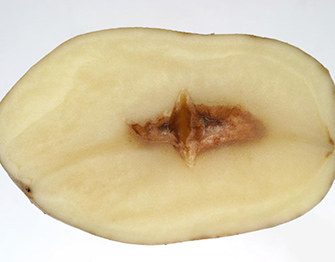Please click here to access the main AHDB website and other sectors.
- Home
- Knowledge library
- Hollow heart and internal browning
Hollow heart and internal browning
Hollow heart and internal browning are different stages of the same internal defect however they commonly occur separately.

Internal browning is most likely to develop at tuber initiation or when the tubers are small but hollow heart can develop at any tuber growth period.
Rapid growth after a period of slow growth can initiate the problems, such as a cold period during early tuber development or prolonged rain after a period of drought.
After the discolouration develops, a period of slow, uniform growth can diminish the disorder before harvest. However, rapid growth can split the discoloured cells, forming small to very large cavities. Dark brown periderm can form on the inner surface of the cavity.
Internal discolouration will usually appear as a short reddish brown discolouration along the central long axis of the tuber, usually at the middle of this line or slightly offset. Colour intensity and defect size can vary widely.
Hollow heart usually shows as lens shaped cavities in the longitudinal or transverse plane and sometimes both (star shaped). Sometimes multiple transverse splits occur along the longitudinal axis. Tiny initial cavities may not be discoloured but larger ones generally are. Often hollow heart is restricted to very large tubers.
Control measures begin at cultivar selection as some are more susceptible than others. Take care to maintain uniform growth. Plant tubers uniformly as close as possible and minimise problems that lead to uneven plant stands. Avoid over irrigation.

